Internet of Things: Applications, Services, and Real-World Examples
VerifiedAdded on 2023/04/08
|6
|951
|379
Report
AI Summary
This report provides a comprehensive overview of the Internet of Things (IoT), exploring its fundamental concepts and applications. It begins with an introduction to IoT, defining it as the connection of everyday physical objects to the internet, enabling them to identify themselves and communicate with other devices. The report then delves into real-world examples of IoT services, including smart metering, asset tracking, and connected vehicles. Smart metering is presented as a crucial step in developing smart grid systems, providing real-time data on energy and water consumption. Asset tracking is highlighted as a key factor for business success, enabling remote monitoring of various assets. The report also discusses connected vehicles, showcasing how IoT is revolutionizing the automotive industry by providing infotainment services and internet access. The document references key literature and provides a foundational understanding of IoT's impact and potential.
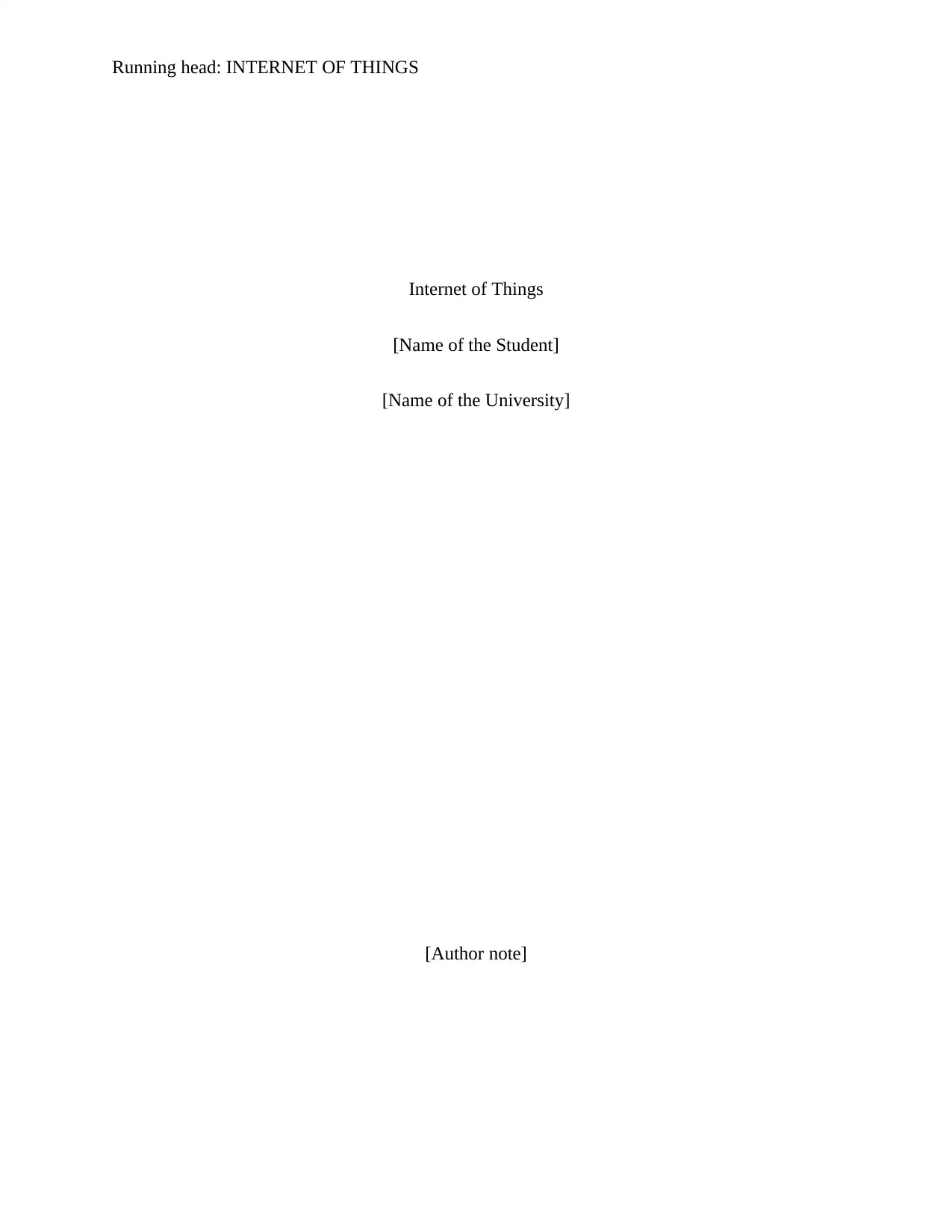
Running head: INTERNET OF THINGS
Internet of Things
[Name of the Student]
[Name of the University]
[Author note]
Internet of Things
[Name of the Student]
[Name of the University]
[Author note]
Paraphrase This Document
Need a fresh take? Get an instant paraphrase of this document with our AI Paraphraser
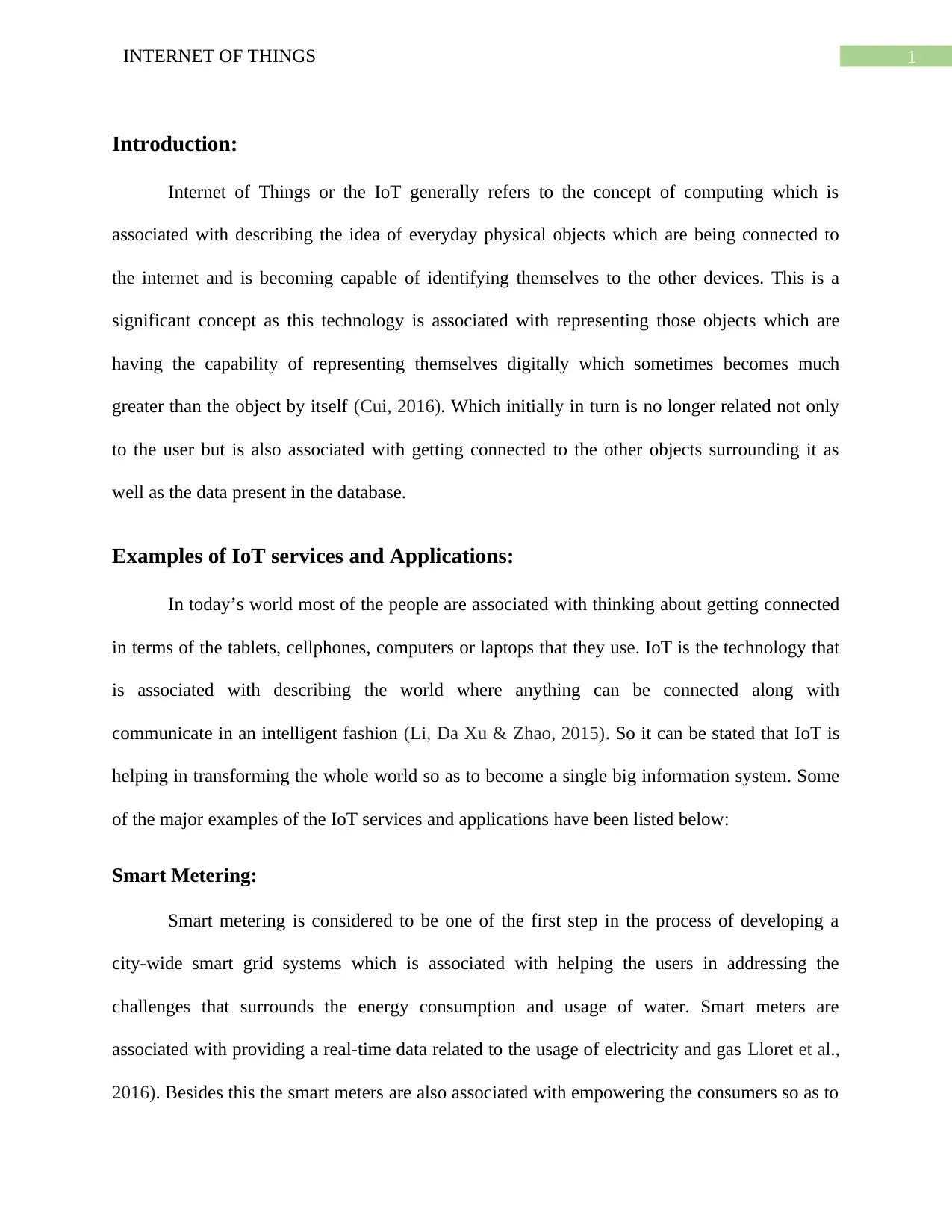
1INTERNET OF THINGS
Introduction:
Internet of Things or the IoT generally refers to the concept of computing which is
associated with describing the idea of everyday physical objects which are being connected to
the internet and is becoming capable of identifying themselves to the other devices. This is a
significant concept as this technology is associated with representing those objects which are
having the capability of representing themselves digitally which sometimes becomes much
greater than the object by itself (Cui, 2016). Which initially in turn is no longer related not only
to the user but is also associated with getting connected to the other objects surrounding it as
well as the data present in the database.
Examples of IoT services and Applications:
In today’s world most of the people are associated with thinking about getting connected
in terms of the tablets, cellphones, computers or laptops that they use. IoT is the technology that
is associated with describing the world where anything can be connected along with
communicate in an intelligent fashion (Li, Da Xu & Zhao, 2015). So it can be stated that IoT is
helping in transforming the whole world so as to become a single big information system. Some
of the major examples of the IoT services and applications have been listed below:
Smart Metering:
Smart metering is considered to be one of the first step in the process of developing a
city-wide smart grid systems which is associated with helping the users in addressing the
challenges that surrounds the energy consumption and usage of water. Smart meters are
associated with providing a real-time data related to the usage of electricity and gas Lloret et al.,
2016). Besides this the smart meters are also associated with empowering the consumers so as to
Introduction:
Internet of Things or the IoT generally refers to the concept of computing which is
associated with describing the idea of everyday physical objects which are being connected to
the internet and is becoming capable of identifying themselves to the other devices. This is a
significant concept as this technology is associated with representing those objects which are
having the capability of representing themselves digitally which sometimes becomes much
greater than the object by itself (Cui, 2016). Which initially in turn is no longer related not only
to the user but is also associated with getting connected to the other objects surrounding it as
well as the data present in the database.
Examples of IoT services and Applications:
In today’s world most of the people are associated with thinking about getting connected
in terms of the tablets, cellphones, computers or laptops that they use. IoT is the technology that
is associated with describing the world where anything can be connected along with
communicate in an intelligent fashion (Li, Da Xu & Zhao, 2015). So it can be stated that IoT is
helping in transforming the whole world so as to become a single big information system. Some
of the major examples of the IoT services and applications have been listed below:
Smart Metering:
Smart metering is considered to be one of the first step in the process of developing a
city-wide smart grid systems which is associated with helping the users in addressing the
challenges that surrounds the energy consumption and usage of water. Smart meters are
associated with providing a real-time data related to the usage of electricity and gas Lloret et al.,
2016). Besides this the smart meters are also associated with empowering the consumers so as to
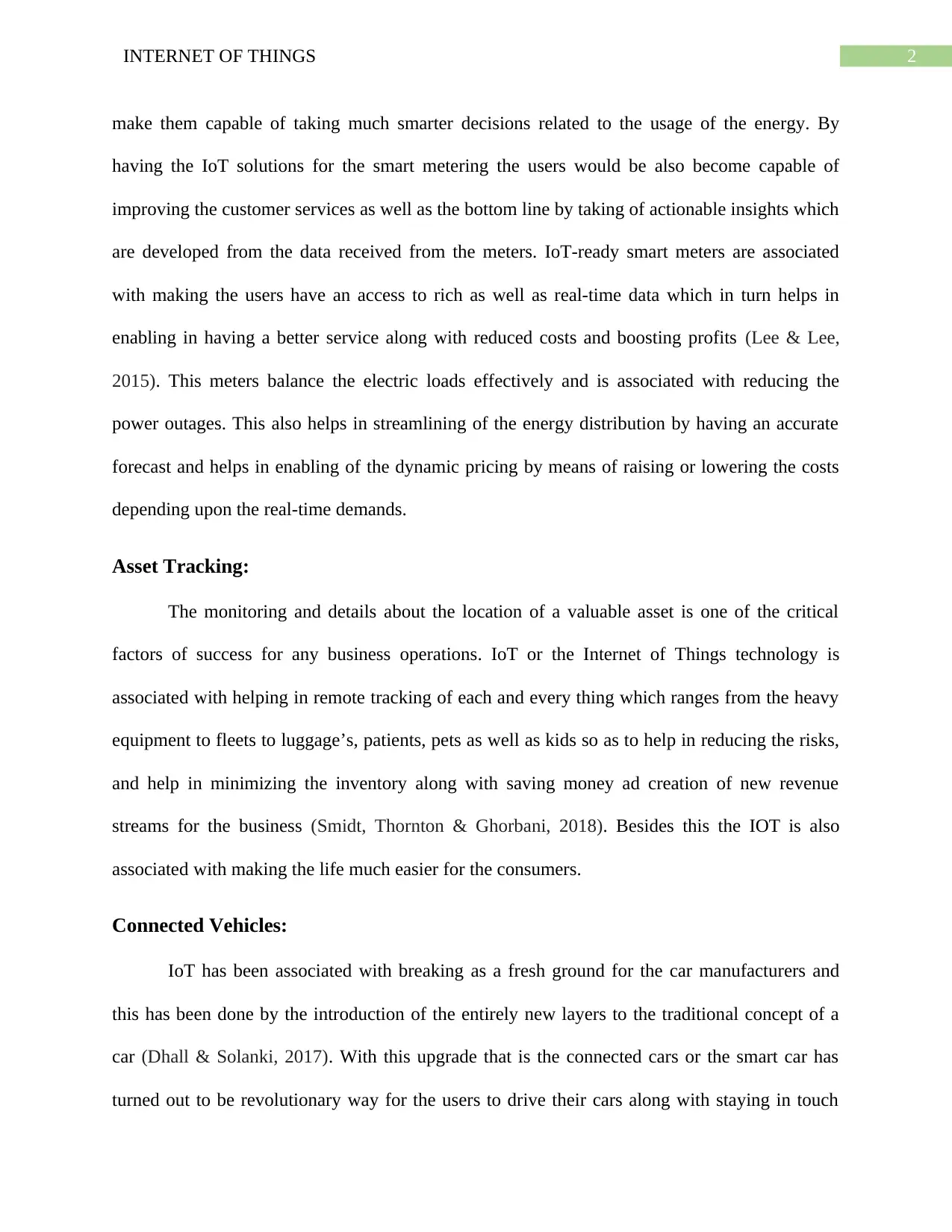
2INTERNET OF THINGS
make them capable of taking much smarter decisions related to the usage of the energy. By
having the IoT solutions for the smart metering the users would be also become capable of
improving the customer services as well as the bottom line by taking of actionable insights which
are developed from the data received from the meters. IoT-ready smart meters are associated
with making the users have an access to rich as well as real-time data which in turn helps in
enabling in having a better service along with reduced costs and boosting profits (Lee & Lee,
2015). This meters balance the electric loads effectively and is associated with reducing the
power outages. This also helps in streamlining of the energy distribution by having an accurate
forecast and helps in enabling of the dynamic pricing by means of raising or lowering the costs
depending upon the real-time demands.
Asset Tracking:
The monitoring and details about the location of a valuable asset is one of the critical
factors of success for any business operations. IoT or the Internet of Things technology is
associated with helping in remote tracking of each and every thing which ranges from the heavy
equipment to fleets to luggage’s, patients, pets as well as kids so as to help in reducing the risks,
and help in minimizing the inventory along with saving money ad creation of new revenue
streams for the business (Smidt, Thornton & Ghorbani, 2018). Besides this the IOT is also
associated with making the life much easier for the consumers.
Connected Vehicles:
IoT has been associated with breaking as a fresh ground for the car manufacturers and
this has been done by the introduction of the entirely new layers to the traditional concept of a
car (Dhall & Solanki, 2017). With this upgrade that is the connected cars or the smart car has
turned out to be revolutionary way for the users to drive their cars along with staying in touch
make them capable of taking much smarter decisions related to the usage of the energy. By
having the IoT solutions for the smart metering the users would be also become capable of
improving the customer services as well as the bottom line by taking of actionable insights which
are developed from the data received from the meters. IoT-ready smart meters are associated
with making the users have an access to rich as well as real-time data which in turn helps in
enabling in having a better service along with reduced costs and boosting profits (Lee & Lee,
2015). This meters balance the electric loads effectively and is associated with reducing the
power outages. This also helps in streamlining of the energy distribution by having an accurate
forecast and helps in enabling of the dynamic pricing by means of raising or lowering the costs
depending upon the real-time demands.
Asset Tracking:
The monitoring and details about the location of a valuable asset is one of the critical
factors of success for any business operations. IoT or the Internet of Things technology is
associated with helping in remote tracking of each and every thing which ranges from the heavy
equipment to fleets to luggage’s, patients, pets as well as kids so as to help in reducing the risks,
and help in minimizing the inventory along with saving money ad creation of new revenue
streams for the business (Smidt, Thornton & Ghorbani, 2018). Besides this the IOT is also
associated with making the life much easier for the consumers.
Connected Vehicles:
IoT has been associated with breaking as a fresh ground for the car manufacturers and
this has been done by the introduction of the entirely new layers to the traditional concept of a
car (Dhall & Solanki, 2017). With this upgrade that is the connected cars or the smart car has
turned out to be revolutionary way for the users to drive their cars along with staying in touch
⊘ This is a preview!⊘
Do you want full access?
Subscribe today to unlock all pages.

Trusted by 1+ million students worldwide
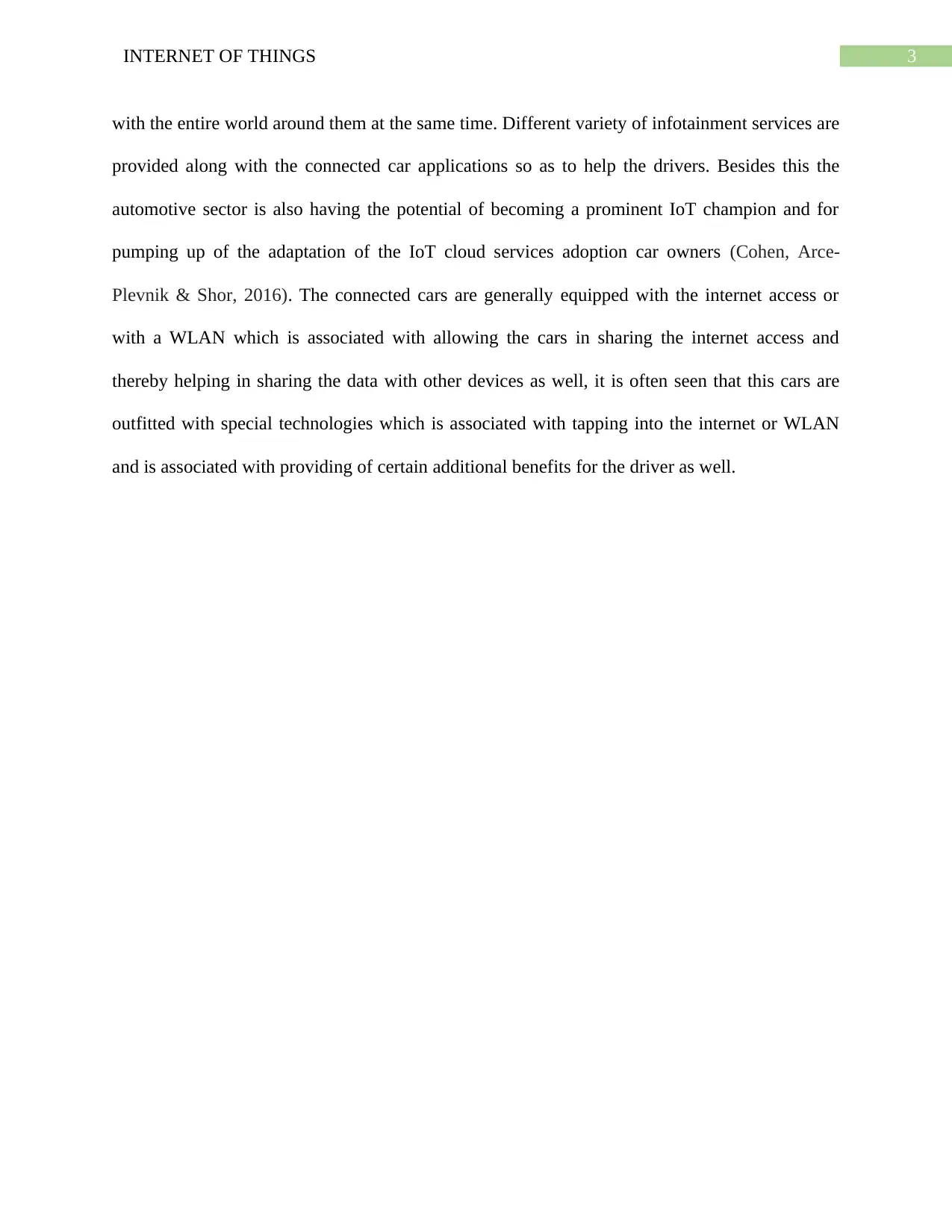
3INTERNET OF THINGS
with the entire world around them at the same time. Different variety of infotainment services are
provided along with the connected car applications so as to help the drivers. Besides this the
automotive sector is also having the potential of becoming a prominent IoT champion and for
pumping up of the adaptation of the IoT cloud services adoption car owners (Cohen, Arce-
Plevnik & Shor, 2016). The connected cars are generally equipped with the internet access or
with a WLAN which is associated with allowing the cars in sharing the internet access and
thereby helping in sharing the data with other devices as well, it is often seen that this cars are
outfitted with special technologies which is associated with tapping into the internet or WLAN
and is associated with providing of certain additional benefits for the driver as well.
with the entire world around them at the same time. Different variety of infotainment services are
provided along with the connected car applications so as to help the drivers. Besides this the
automotive sector is also having the potential of becoming a prominent IoT champion and for
pumping up of the adaptation of the IoT cloud services adoption car owners (Cohen, Arce-
Plevnik & Shor, 2016). The connected cars are generally equipped with the internet access or
with a WLAN which is associated with allowing the cars in sharing the internet access and
thereby helping in sharing the data with other devices as well, it is often seen that this cars are
outfitted with special technologies which is associated with tapping into the internet or WLAN
and is associated with providing of certain additional benefits for the driver as well.
Paraphrase This Document
Need a fresh take? Get an instant paraphrase of this document with our AI Paraphraser
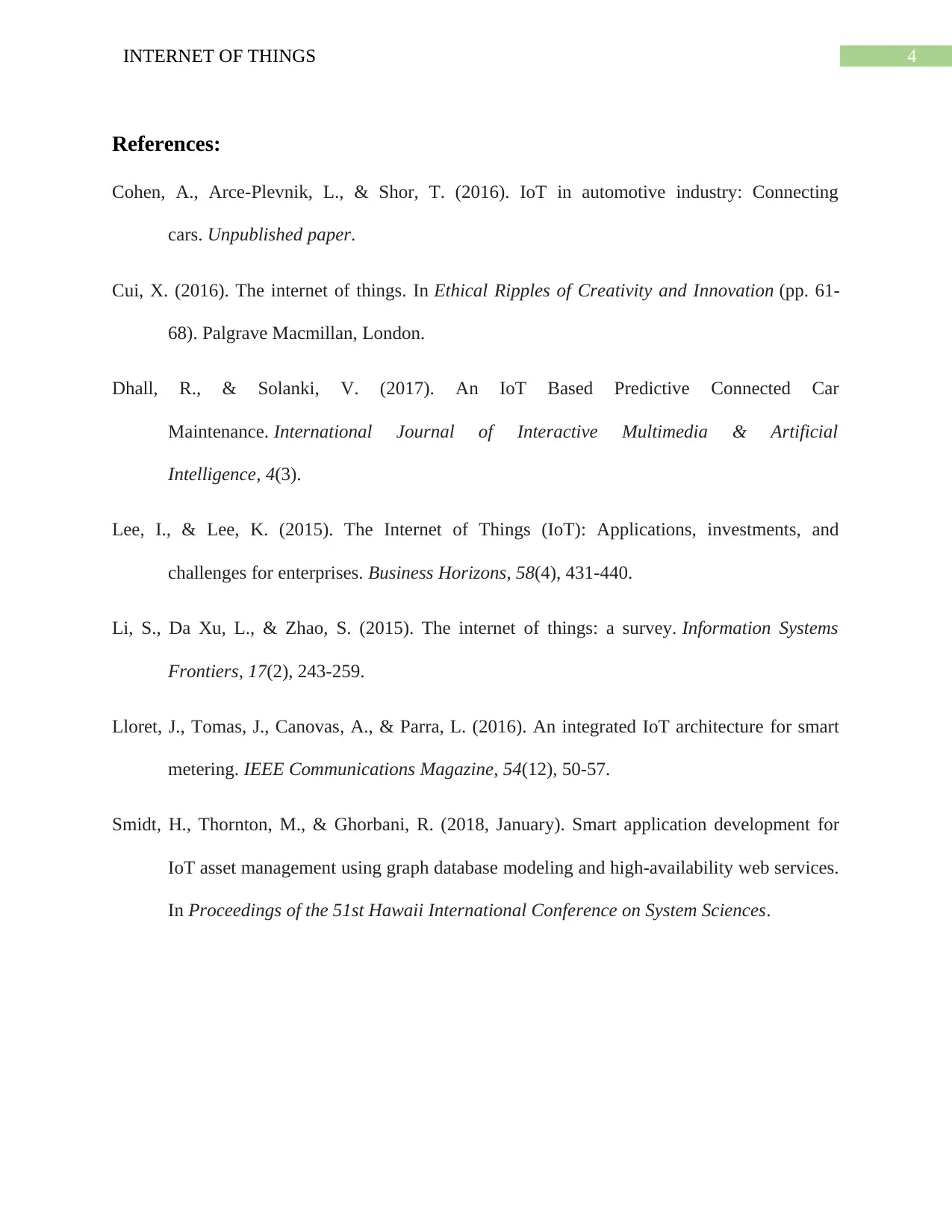
4INTERNET OF THINGS
References:
Cohen, A., Arce-Plevnik, L., & Shor, T. (2016). IoT in automotive industry: Connecting
cars. Unpublished paper.
Cui, X. (2016). The internet of things. In Ethical Ripples of Creativity and Innovation (pp. 61-
68). Palgrave Macmillan, London.
Dhall, R., & Solanki, V. (2017). An IoT Based Predictive Connected Car
Maintenance. International Journal of Interactive Multimedia & Artificial
Intelligence, 4(3).
Lee, I., & Lee, K. (2015). The Internet of Things (IoT): Applications, investments, and
challenges for enterprises. Business Horizons, 58(4), 431-440.
Li, S., Da Xu, L., & Zhao, S. (2015). The internet of things: a survey. Information Systems
Frontiers, 17(2), 243-259.
Lloret, J., Tomas, J., Canovas, A., & Parra, L. (2016). An integrated IoT architecture for smart
metering. IEEE Communications Magazine, 54(12), 50-57.
Smidt, H., Thornton, M., & Ghorbani, R. (2018, January). Smart application development for
IoT asset management using graph database modeling and high-availability web services.
In Proceedings of the 51st Hawaii International Conference on System Sciences.
References:
Cohen, A., Arce-Plevnik, L., & Shor, T. (2016). IoT in automotive industry: Connecting
cars. Unpublished paper.
Cui, X. (2016). The internet of things. In Ethical Ripples of Creativity and Innovation (pp. 61-
68). Palgrave Macmillan, London.
Dhall, R., & Solanki, V. (2017). An IoT Based Predictive Connected Car
Maintenance. International Journal of Interactive Multimedia & Artificial
Intelligence, 4(3).
Lee, I., & Lee, K. (2015). The Internet of Things (IoT): Applications, investments, and
challenges for enterprises. Business Horizons, 58(4), 431-440.
Li, S., Da Xu, L., & Zhao, S. (2015). The internet of things: a survey. Information Systems
Frontiers, 17(2), 243-259.
Lloret, J., Tomas, J., Canovas, A., & Parra, L. (2016). An integrated IoT architecture for smart
metering. IEEE Communications Magazine, 54(12), 50-57.
Smidt, H., Thornton, M., & Ghorbani, R. (2018, January). Smart application development for
IoT asset management using graph database modeling and high-availability web services.
In Proceedings of the 51st Hawaii International Conference on System Sciences.

5INTERNET OF THINGS
⊘ This is a preview!⊘
Do you want full access?
Subscribe today to unlock all pages.

Trusted by 1+ million students worldwide
1 out of 6
Related Documents
Your All-in-One AI-Powered Toolkit for Academic Success.
+13062052269
info@desklib.com
Available 24*7 on WhatsApp / Email
![[object Object]](/_next/static/media/star-bottom.7253800d.svg)
Unlock your academic potential
Copyright © 2020–2025 A2Z Services. All Rights Reserved. Developed and managed by ZUCOL.





